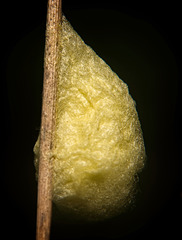Günter Klaus' photos with the keyword: Natur-Kokon-Insekt-Brackwespe-Makro
Ein fertiger Kokon einer Brackwespe :)) A finishe…
| 06 May 2022 |
|
|
|
Eine sehr interessante Entdeckung habe ich auf meiner Runde in der Natur gehabt,auf einen Halm sah ich so einen Kokon,ich wußte zuerst nicht,was das sein konnte!Bin dann zufällig beim Googeln über diesen Link gestossen:
www.flickr.com/photos/achimowl/26318526339
Fertiger Kokon einer Brackwespe
Brackwespen legen ihre Eier mit Hilfe eines speziellen Legestachels häufig in Schmetterlingsraupen. Das Wirtstier wird dadurch gelähmt, und aus den Eiern in seinem Körper schlüpfen die Wespenlarven. Diese ernähren sich von ihrem Wirt und töten ihn so am Ende. Auf seiner Körperhülle spinnen sie anschließend ihre Kokons und verpuppen sich.
Später werden die Gespinste gelb und von der parasitierten Raupe ist in der Regel nichts mehr zu sehen.
Man sieht eben auch öfters,die Natur kann auch anderes sein,wenn es ums Überleben geht!!
I had a very interesting discovery on my walk in nature, I saw a cocoon on a stalk, I didn't know at first what it could be! Then I accidentally came across this link while googling:
www.flickr.com/photos/achimovl/26318526339
Finished cocoon of a braconid wasp
Braconid wasps often lay their eggs in caterpillars with the help of a special ovipositor. This paralyzes the host animal, and the wasp larvae hatch from the eggs inside its body. They feed on their host and end up killing him. They then spin their cocoons on its body shell and pupate.
Later, the webs turn yellow and the parasitized caterpillar is usually no longer visible.
You can see that nature can be different when it comes to survival!!
J'ai fait une découverte très intéressante lors de ma promenade dans la nature, j'ai vu un cocon sur une tige, je ne savais pas au début ce que ça pouvait être ! Puis je suis tombé par hasard sur ce lien en cherchant sur Google :
www.flickr.com/photos/achimovl/26318526339
Cocon fini d'une guêpe braconide
Les guêpes braconides pondent souvent leurs œufs dans les chenilles à l'aide d'un ovipositeur spécial. Cela paralyse l'animal hôte et les larves de guêpes éclosent des œufs à l'intérieur de son corps. Ils se nourrissent de leur hôte et finissent par le tuer. Ils tissent ensuite leurs cocons sur sa carapace et se nymphosent.
Plus tard, les toiles jaunissent et la chenille parasitée n'est généralement plus visible.
Vous pouvez voir que la nature peut être différente quand il s'agit de survie !!
Jump to top
RSS feed- Günter Klaus' latest photos with "Natur-Kokon-Insekt-Brackwespe-Makro" - Photos
- ipernity © 2007-2025
- Help & Contact
|
Club news
|
About ipernity
|
History |
ipernity Club & Prices |
Guide of good conduct
Donate | Group guidelines | Privacy policy | Terms of use | Statutes | In memoria -
Facebook
Twitter

